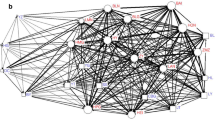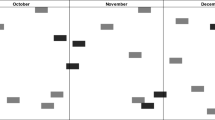Abstract
Three different quantitative parameters (frequency, duration and distribution) were used for studying allogrooming behavior in and outside the mating season in a Japanese macaque social group confined at the Rome Zoo. On the whole, 106 hr of observations were made using an “all occurrences” recording technique. Although individual grooming scores were collected, the quantitative analyses were mostly focused on the relationships between and within the age/sex classes. The mating season caused two basic changes in allogrooming: (1) an amount increase; and (2) a widening of individuals' range of interactions. Strikingly, the former variation proved to be widely independent of the latter. Relationships between the age/sex classes changed so that the mature females became the main target of grooming from other group members, male and female. On the contrary, two interactional trends did not seem to be affected by the mating season: the tendencies to groom agemates chiefly and to interact with relatives closely. However, the reorganization of grooming relationships did not appear to weaken the group cohesion.
Similar content being viewed by others
References
Alexander, B. K. &J. M. Bowers, 1967. The social structure of the Oregon troop of Japanese macaques.Primates, 8: 333–340.
Carpenter, C. R., 1942. Sexual behavior of free ranging rhesus monkeys (Macaca mulatta). I. Specimens, procedures and behavioral characteristics of estrus.J. Comp. Psychol., 33: 113–142.
Chance, M. R. A., 1956. Social structure of a colony ofMacaca mulatta.Br. J. Anim. Behav., 4: 1–13.
Drickamer, L. C., 1976. Quantitative observations of grooming behavior in free-rangingMacaca mulatta.Primates, 17: 323–335.
Fedigan, L. M., 1976.A Study of Roles in the Arashiyama West Troop of Japanese Monkeys (Macaca fuscata). Contributions to Primatology, Vol. 9, S. Karger, Basel.
Gray Eaton, G., 1976. The social order of Japanese macaques.Sci. Amer., 235: 97–106.
Hinde, R. A., 1976. Interactions, relationships and social structure.Man, 11: 1–17.
Kaufmann, J. H., 1965. A three-year study of mating behavior in a free-ranging band of rhesus monkeys.Ecology, 46: 500–512.
————, 1967. Social relations of adult males in a free-ranging band of rhesus monkeys. In:Social Communication Among Primates,S. A. Altmann (ed.), Univ. of Chicago Press, Chicago, pp. 73–98.
Kummer, H., 1968.Social Organization of Hamadryas Baboons. Univ. of Chicago Press, Chicago.
Lindburg, D. G., 1973. Grooming behavior as a regulator of social interactions in rhesus monkeys. In:Behavioral Regulators of Behavior in Primates,C. R. Carpenter (ed.), Bucknell Univ. Press, Lewisburg, pp. 124–148.
Loy, J., 1971. Estrous behavior of free-ranging rhesus monkeys (Macaca mulatta).Primates, 12: 1–31.
Oki, J. &Y. Maeda, 1973. Grooming as a regulator of behavior in Japanese macaques. In:Behavioral Regulators of Behavior in Primates,C. R. Carpenter (ed.), Bucknell Univ. Press, Lewisburg, pp. 149–163.
Reynolds, V., 1970. Roles and role change in monkey society: the consort relationship of rhesus monkeys.Man, 5: 450–465.
Rosenblum, L. A., I. C. Kaufman &A. J. Stynes, 1966. Some characteristics of adult social and autogrooming patterns in two species of macaque.Folia Primatol., 4: 438–451.
Rowell, T. E., 1969. Intra-sexual behaviour and female reproductive cycles of baboons (Papio anubis).Anim. Behav., 17: 159–167.
————, 1972. Female reproduction cycles and social behavior in primates.Adv. Stud. Behav., 4: 69–105.
Sade, D. S., 1965. Some aspects of parent-offspring and sibling relations in a group of rhesus monkeys, with a discussion of grooming.Amer. J. Phys. Anthropol., 23: 1–18.
Seyfarth, R. M., 1977. A model of social grooming among adult female monkeys.J. Theor. Biol., 65: 671–698.
Simonds, P. E., 1974.The Social Primates. Harper & Row Pub., New York.
Slater, P. J. B., 1978. Data collection. In:Quantitative Ethology,P. W. Colgan (ed.), John Wiley & Sons, New York, pp. 7–24.
Southwick, C. H., M. A. Beg &M. R. Siddiqi, 1965. Rhesus monkeys in North India. In:Primate Behavior: Field Studies of Monkeys and Apes,I. DeVore (ed.), Holt, Rinehart & Winston, New York, pp. 111–159.
Stephenson, G. R., 1974. Social structure of mating activity in Japanese macaques. In:Proc. Symp. 5th Congr. Int. Primatol. Soc.,S. Kondo,M. Kawai,A. Ehara &S. Kawamura (eds.), Japan Science Press, Tokyo, pp. 63–115.
Tokuda, K., 1961–62. A study on the sexual behavior in the Japanese monkey troop.Primates, 3(2): 1–40.
Troisi, A., F. R. D'Amato, R. Fuccillo &S. Scucchi, 1982. A general overview of the confined group of Japanese macaques in Rome zoo.Antropologia, 1: 1–7.
Washburn, S. L. &I. DeVore, 1961. The social life of baboons.Sci. Amer., 204: 62–71.
Wolfe, L., 1979. Behavioral patterns of estrous females in the Arashiyama West troop of Japanese macaques (Macaca fuscata).Primates, 20: 525–534.
Yamada, M., 1963. A study of blood-relationship in the natural society of the Japanese macaque: An analysis of co-feeding, grooming and playmate relationships in Minoo-B troop.Primates, 4(3): 43–65.
Zuckerman, S., 1932.The Social Life of Monkeys and Apes. Kegan Paul, London.
Author information
Authors and Affiliations
Additional information
Abstract of this paper was read at the 8th Congress of the International Primatological Society, Florence, July 7–12, 1980.
About this article
Cite this article
D'Amato, F.R., Troisi, A., Scucchi, S. et al. Mating season influence on allogrooming in a confined group of Japanese macaques: A quantitative analysis. Primates 23, 220–232 (1982). https://doi.org/10.1007/BF02381162
Received:
Accepted:
Issue Date:
DOI: https://doi.org/10.1007/BF02381162




